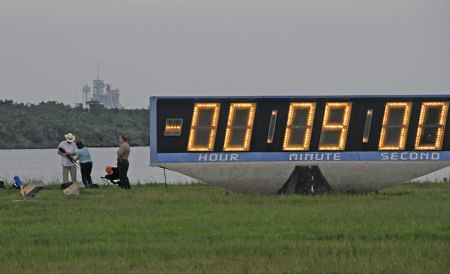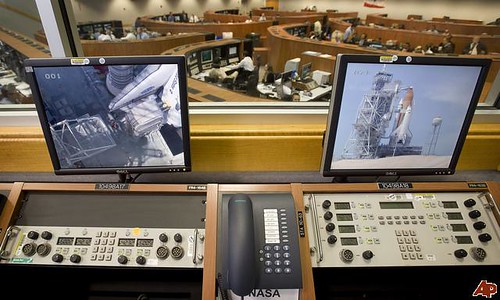Shuttle? Check. Launchpad? Check. Systems? Personnel?
Yep, there are various things to be done before an actual launch, and those systems, and several situations are monitored very closely by several people. And those people have to be checking the shuttle and launchpad systems over 3 to 4 days before the actual launch. I can’t tell you the exact realtime frame because that usually varies thanks to the various built-in holds in the countdown. Which brings us to our first, and most important system.
The Countdown/Mission Elapsed Timer
That up there is one of the most famous timepieces in the planet: the NASA countdown clock. It’s called a countdown clock until the shuttle launches, in which it becomes a “Mission Elapsed Timer”, which is exactly what it is, a timer of the mission’s duration.
The time is read normally when it’s counting the mission duration, but when it’s counting down towards the actual launch, the time is read in the following format: T minus x days, x hours, x minutes, x seconds and counting (or holding). Of course, if the days are zero, it’s ommited, same for hours, and same for minutes when it’s counting from 59 seconds downward. How do you read the above pic?
It would read T minus 9 minutes and counting, but at the moment the pic was taken, it was read as T-minus 9 minutes and holding, because it’s in a built-in hold. ….a what?
A built-in hold are programmed holds in the countdown, where the count stops for minutes or hours, before it resumes. Usually, things are done during these holds, and for the hold to release the timer, they have to have done those things successfully, things like fueling the external tank, turning stuff on and checking, or the infamous flight readiness poll, which is the go/no go for launch call.
The Launch Team
This is a view from an upper console in Kennedy Space Center’s Firing Room 4, where most of the launch team is assembled during the countdown. There are 3 teams that verify if all systems are ok and if all conditions are met for launch. Inside one of those 3 teams is “Houston Flight”, which is none other than Mission Control Center, Houston, but in a launch, they answer to one of those 3 teams. Launch poll goes in the following order: NTD polls his team, reports to Launch Director, Launch Director polls his team, asks for MMT, and MMT gives their go/nogo. Launch Director then reports to the crew that they’re either go for launch, or the launch got scrubbed to a later date.
The NTD, or Nasa Test Director, is in charge or the safety of all personnel on and off the launch pad, including the crew, and works to integrate all of the systems, personnel and crew, testing to verify if all is go for launch. This is the director that initiates the Final Flight Readiness Poll. The teams that answer to the NTD are the following:
- OTC - Orbiter Test Conductor, checks all orbiter systems
- TBC - Tank/Booster Test Conductor and Tank/Booster Test Conductor, checks External Tank and Solid Rocket Booster systems and fueling operations.
- PTC - Payload Test Conductor, verifies the cargo is working and stowed properly.
- LPS - Launch Processing System Test Conductors, verifies the systems controlling major aspects of the launch
- Houston Flight – Mission Control Center, where the mission will be watched over from.
- MILA - Merritt Island Spaceflight Tracking & Data Network Stations, used to track the shuttle on its mission, using the powerful NASA TDRS Satellite Network.
- STM - Support Test Manager
- Safety Console - Safety Console Coordinator
- SPE - Shuttle Project Engineer
- LRD - Landing and Recovery Director
- SRO - Superintendent of Range Operations, checks for airspace and weather in the flight path of the shuttle, and checks weather constrains 10 nautical miles around the launchpad and 20 nautical miles around the shuttle landing facility in case of an abort.
- GLS – Ground Launch Sequencer, an engineer watching over the GLS, a computer managing the final 9 minutes to launch.
- CDR – Mission Commander, aboard the shuttle
The Launch Director’s team verifies that all 3 teams, including his team, is ready to support a launch, and gives the final decision for a go/nogo to launch. Mike Leinbach has been the Launch Director for the past several missions. When called to verify go/nogo for launch, he polls his team at the moment, which includes the chief engineer (supervises flight hardware and launch systems and their integration into the launch), the shuttle safety mission assurance officer (advisor for mission management team), payload manager (checks out the cargo to be taken), and range weather (ensures all weather criteria allows for a good launch and, if needed, a good return to the launch site in the event of an abort). Afterwards, Mission Management gives their go, and the Launch Director gives his final decision, and informs it to the shuttle crew.
The Mission Management Team are the executives that work with… well… executive problems and issues regarding a launch and a mission. They are the last to be polled, and the last to report their go/nogo for launch. Up to date, the leader of the Mission Management Team, Mike Moses, polls his team, and when called, gives the go/nogo for launch on behalf of his team.
I’ll give the actual transcript and more explanations of the countdown in the next blog. (finally!)



No comments:
Post a Comment